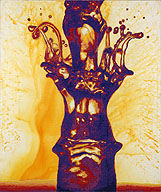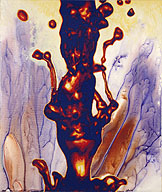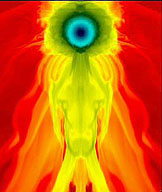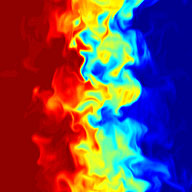Simulations - scientific sources for specific images(see also: Simulations: the science behind the images)On this page I discuss some of the scientific images that I used to make the paintings. Seeing reproductions side-by-side in this manner emphasizes the similarities between source and painting, especially when color is not altered. A comparison of higher resolution details (as here) reveals the issues of process and material that arise in enlarging a tiny video still to a 7-foot painting. |
|
Jonathan Feldschuh, Drop Formation #1, acrylic on canvas over panel, 57" x 48", 2005 |
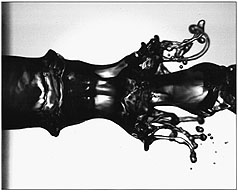 Ligament Mediated Drop Formation, Ph. Marmottant and E. Villermaux, LEGI, Grenoble and IRPHE, Marseille |
This was a benchtop simulation of a problem in fluid
dynamics. The original image is presumably a high-speed strobe
photograph of something that, except for its short duration, could be seen
by the naked eye. I decided to flip the images to a vertical orientation, and present them in a color palette loosely based on black-body radiation. I painted process-based abstractions as backgrounds for the paintings (in other words, I allowed the pigment and medium to interact in a semi-controlled fashion by pouring and splashing them together). The original research is described in Ligament Mediated Drop Formation, Ph. Marmottant and E. Villermaux, PHYSICS OF FLUIDS VOLUME 13, NUMBER 9 SEPTEMBER 2001 |
|
Jonathan Feldschuh, Drop Formation #2, acrylic on canvas over panel, 57" x 48", 2004 |
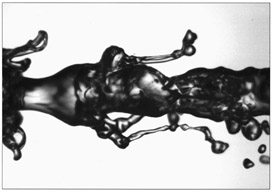 |
|
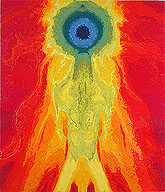 Jonathan Feldschuh, SN1a.5.28, acrylic on canvas over panel, 57" x 48", 2005 |
still; Marietta, Model of a SNIa blast interacting with a main sequence star I |
These paintings are based on still images from a
low-resolution animation. This is a simulation of a supernova in a binary
star system. One star in the system has exploded, and the movie
depicts what happens to its companion. The exploded star would be off
the top of the frame; the surviving star is seen as a ball, and the plume
of stripped material stretches below it. The two stills shown are from late
in each animation As you can see, I have retained the color scheme used by the scientists to make these paintings. Watching the short loop, I was struck by their iconic power as still images. The "neutral" rainbow palette combined with the bilateral symmetry and suggestive figural qualities of the Rorschach-like formations produce images that for me have a decidedly "psychedelic" quality. The original research is described in "Type IA Supernova Explosions in Binary Systems: The Impact on the Secondary Star and Its Consequences" (Marietta, et.al. 2000ApJS..128..615M)
|
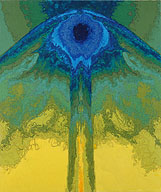 Jonathan Feldschuh, SN1a.4.06, acrylic on canvas over panel, 78" x 67", 2005 |
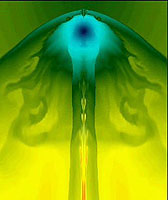 animation still |
|
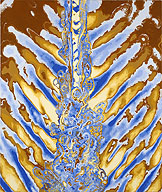 Jonathan Feldschuh, Mach Wave #1, acrylic on canvas over panel, 57" x 48", 2005 |
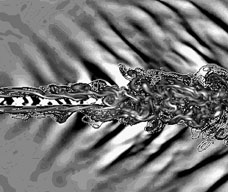 |
This is another painting based on a low-res animation still. In this case the level of detail was so great (particularly the churning ribbon forms) compared to the resolution of the source that I was pushed more and more to abstraction. I chose a palette that suggested sky and desert. The source is a hybrid representation of a two-dimensional slice of a 3-D numerical simulation. The original research is described in "Mach Wave Radiation from a Jet at Mach 1.92", R. Darke and J. B. Freund, PHYSICS OF FLUIDS VOLUME 13, NUMBER 9 SEPTEMBER 20 |
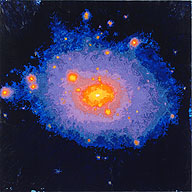 Jonathan Feldschuh,
Cold, Dark, |
Cold Dark Matter Galaxy formation, Thomas Quinn (UW) N-Body/SPH et. al |
This is a simulation of galaxy formation using various
assumptions about cold dark matter -- the mysterious missing mass which
cosmologists have been positing, in part as a way of making their
simulations gibe with what we actually observe. I was struck by the
image as an icon of multiplicity and spontaneous generation. I found
the warm/cool palette of the original image very apt and reproduced it. The original image was produced by Thomas Quinn with the Arctic Region Supercomputing Center.
|
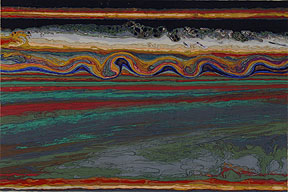 Jonathan Feldschuh, Film #1 , acrylic on canvas over panel, 32" x 48", 2004 |
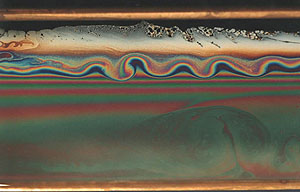 |
This is another desktop fluid-dynamics simulation. I mostly kept the frosty, iridescent palette. I was attracted to the abstract landscape features of this image, which is probably a few inches across but suggests mountains, sea, and clouds. I used a lot of directed pours to create the swirling forms in the lower half of the canvas. The original research is described in "Evaporatively Driven Convection in a Draining Soap Film", Jan M. Skotheim and John W. M. Bush, PHYSICS OF FLUIDS VOLUME 12, NUMBER 9 SEPTEMBER 2000
|
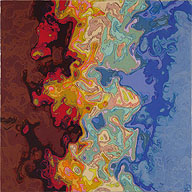 Jonathan Feldschuh, DNS Chemical Mixing #2 , acrylic on canvas over panel, 36" x 36", 2004 |
|
This was one of the very first Simulations images.
I was attracted to it as an almost pure abstraction. I altered the
original rainbow palette to include more earth and muted tones. The original image is a supercomputer simulation of fluid mixing, done by Stephen de Bruyn Kops at ARSC.
|
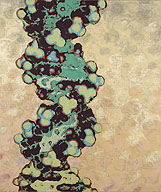 Jonathan Feldschuh, Big DNA, acrylic on canvas over panel, 57" x 48", 2002 |
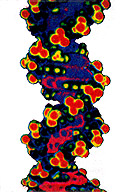 DNA space-filling model |
This painting is based on a low-resolution scan of a newspaper clipping of a space-filling model of DNA. I decided to change the palette to something green that suggested a different notion of "organic" - perhaps a microcosmic beanstalk. |
|
Jonathan Feldschuh, Fingerlings, acrylic on panel, 18" x 16", 2005 |
These small paintings are not based so explicitly on specific
scientific images, but are more loosely inspired by: Hubble images of interstellar gas |
|
|
Jonathan Feldschuh, Loss of Perspective, acrylic on panel, 18" x 16", 2000 |
cell cultures / histology? | |
|
Jonathan Feldschuh, Inflection Point, acrylic on panel, 18" x 16", 2000 |
cilia? slime mold? |
| - Jonathan Feldschuh, July 2005 |
| Look at more
statements |
